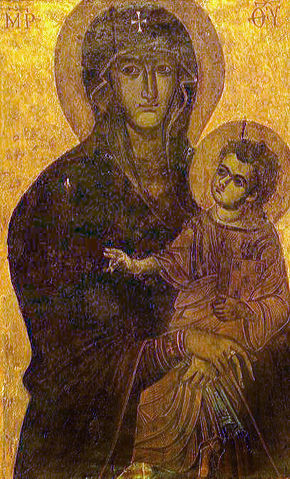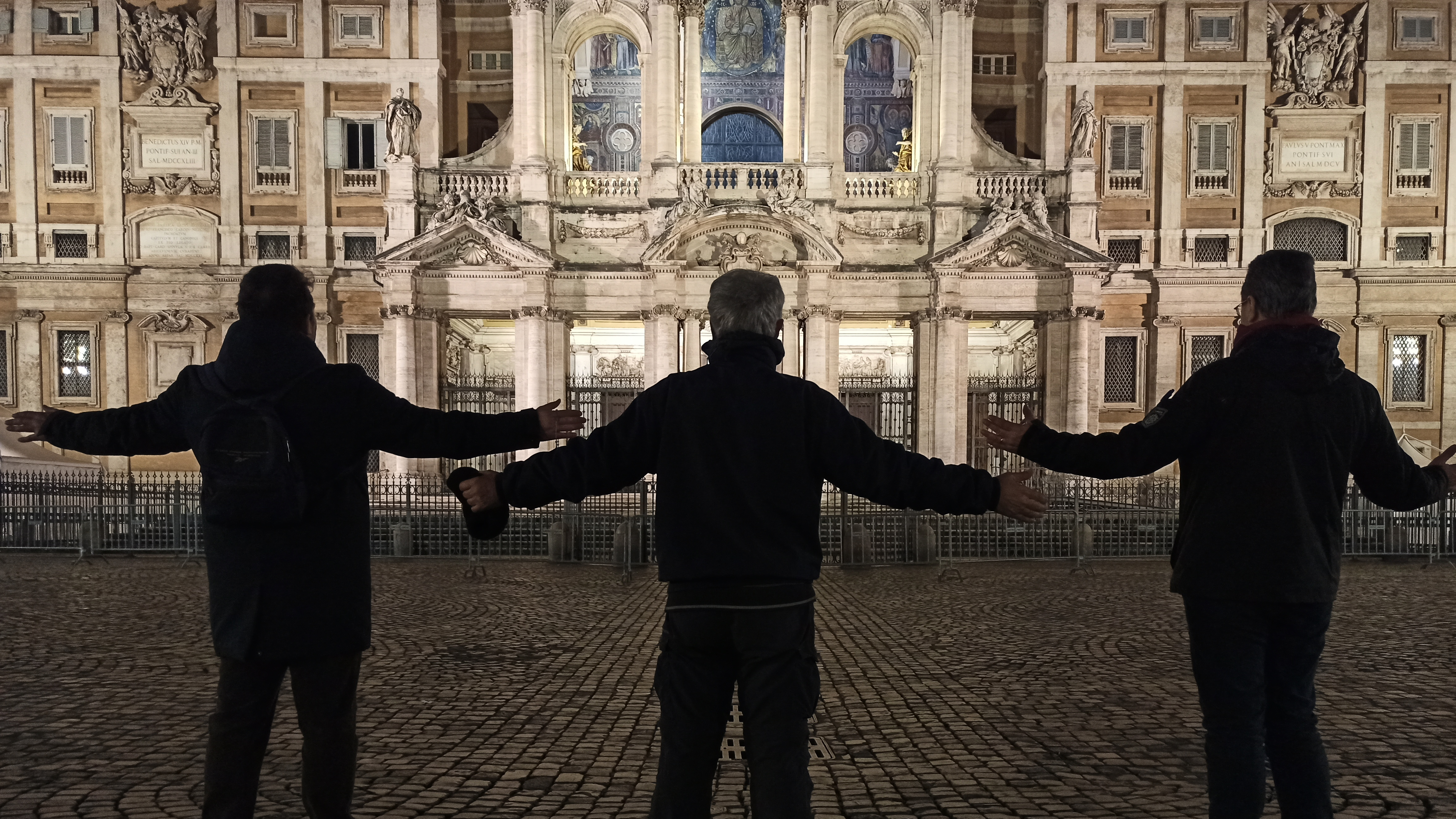WE INVITE YOU TO JOIN US VIA VIDEO
AT FROM ROME INFO VIDEO
Español – Français — Deutsch — Polski
Perpetual Supplica
THESE PRAYERS ARE SAID EACH MIDNIGHT
IN FRONT OF THE BASILICA OF SANTA MARIA MAGGIORE AT ROME
This devotion is inspired by the request made by Our Lady Herself in
Bl. Anne Catherine Emmerich’s Vision of
August 25, 1822: “I know not now how I went to Rome last night, but I found myself near the church of Santa Maria Maggiore. Around it I saw crowds of poor, pious souls, in great distress and anxiety on account of the Pope’s disappearance and the agitation and alarming reports throughout the city. Led by one common impulse, they had come to invoke the Mother of God. They did not expect to find the church open, they intended only to pray outside. But I was inside, I opened the door and they entered, astounded at the door’s opening of itself. I was standing aloof where they could not see me. There was no service, only the chancel-lamps were burning, and the people knelt in quiet prayer. Then the Mother of God appeared. She said that great tribulations were at hand; that the people must pray earnestly with extended arms, if only for the length of three Our Fathers, for it was thus that her Son had prayed for them upon the Cross; that they should rise at midnight to pray thus; that they should continue to come to Her church which they would always find open; and that they should, above all, pray for the extirpation of the Church of Darkness. … I know not whether the people saw the apparition or not, but they must have been impressed by something supernatural for, when the Blessed Virgin said they should pray to God with arms extended, all lifted up their arms … It seemed to be an association of prayer.” From this time Sister Emmerich assisted nightly at the pious exercises at Santa Maria Maggiore. (The Life and Revelations of Ann Catherine Emmerich, Book 2)
(Prayers will be said in Italian, Black, and English: Blue)
The Prophetic Prayer of Pope Benedict XVI
TO OUR LADY OF SANTA MARIA MAGGIORE
KNOWN AT ROME AS: SALUS POPULI ROMANI*
(May 7, 2005)

In Nomine Patris et Filii et Spiritus Sancti. Amen.
Tutta Santa, degna di ogni onore,
Tu la migliore offerta
che l’umanità possa presentare a Dio.
All Holy, Worthy of every honor,
Thou, the best offering
Which humanity can present to God.
Vergine Madre, Madre sempre vergine,
supplichi materna al Figlio Tuo.
Virgin Mother, Ever-Virgin Mother,
Offer a maternal supplication to Thy Son.
Conduci sino al porto la barca della Chiesa,
scansando gli scogli e vincendo i marosi.
Bring the Barque of the Church to port,
avoiding reefs and conquering stormy seas.
Custodisci questa città;
Conforta chi vi giunge,
senza tetto né difesa,
ed estendi a tutti il Tuo sostegno.
Guard this City;
Comfort who comes here,
without shelter nor defense,
and extend Your protection to all.
Con fede professiamo a Te, Genetrice di Dio;
Con amore Ti onoriamo,
Con speranza Ti preghiamo,
Ti proclamiamo beata.
With faith we profess Thee, Mother of God;
With love we honor Thee;
With hope we pray Thee
We proclaim Thee blessed.
Tu, mia Signora, mio conforto da Dio,
aiuto alla mia inesperienza,
accogli la preghiera che rivolgo a Te.
Thou, My Lady, My consolation from God,
help for my inexperience,
receive the supplication which I make to Thee.
Tu per tutti fonte di gioia,
rendimi degno di esultare insieme a Te.
Thou, who for all are a fountain of joy,
make me worthy to exult together with Thee.
Guarda l’assemblea dei credenti,
Madre del Salvatore;
allontana da loro sventure e afflizioni;
liberali dal male e dal maligno;
proteggili con l’abbondanza della Tua benevolenza.
Watch over the assembly of believers,
Mother of the Savior;
remove from them misfortunes and afflictions;
free them from evil and from the Evil One;
protect them with the abundance of Thy benevolence.
Al ritorno glorioso del Tuo Figlio, nostro Dio,
difendi con la Tua materna intercessione
la nostra fragilità umana
ed accompagnaci sino alla vita eterna
con la Tua mano gentile,
Tu che sei potente, perche Madre.
At the glorious return of Thy Son, our God,
defend with Thy maternal intercession
our human fragility
and accompany us unto eternal life
with Thy gentle hand,
Thou who art powerful, as a Mother.
Amen.
77 Our Fathers, that is 7 Rosary Decades of Our Fathers.
3 in Latin
71 Our Fathers: One decade in Italian, one in English, alternating
3 in Latin
3 Gloria Patri
Sacro Cuore di Gesù, abbi pietà di noi!
Sacred Heart of Jesus, have mercy on us!
Cuore Immacolato di Maria, prega per noi!
Immaculate Heart of Mary, pray for us!
San Giuseppe, Patrono della Chiesa, prega per noi!
Saint Joseph, Patron of the Church, pray for us!
PREGHIERA A SAN MICHELE ARCANGELO
San Michele Arcangelo, difendici nella battaglia, contro la perfidia e le insidie del diavolo sii Tu il nostro sostegno. Che Dio eserciti il suo domino su di lui, noi supplichevoli Lo preghiamo! E tu, Principe delle milizie celesti, ricaccia nell’inferno satana e gli altri spiriti maligni, che si aggirano in questa Città a perdizione delle anime.
PRAYER TO SAINT MICHAEL, THE ARCHANGEL
Saint Michael, the Archangel, defend us in battle, be our protection against the wickedness and snares of the Devil. May God rebuke him, we humbly pray, and do thou, o prince of the Heavenly Host, by the Divine Power, cast into Hell Satan and all the evils spirits who prowl about this City seeking the ruin of souls. Amen.
San Gabriele Arcangelo, prega per noi!
Saint Gabriel the Archangel, pray for us!
San Raffaele Arcangelo, prega per noi!
Saint Raphael the Archangel, pray for us!
San Pio V, prega per noi!
Saint Pius V, pray for us!
San Francesco di Assisi, prega per noi!
Saint Francis of Assisi, pray for us!
San Antonio di Padova, prega per noi!
Saint Anthony of Padua, pray for us!
Santa Rosalia di Palermo, prega per noi!
Saint Rosalia of Palermo, pray for us!
Beata Anna Caterina Emmerich, prega per noi e prega con noi!
Bl. Ann Catherine Emmerich, pray for us and pray with us!
In Nomine Patris et Filii e Spiritus Sancti. Amen.
HYMN TO OUR LADY
SALUS POPULI ROMANI
Al tuo tempio secolare
di ori e marmi rilucente
siamo accorsi ad implorare
il materno tuo favor.
At Thy Ancient Temple
of shinning gold and marble
we have come to implore
Thy Materna favor.
R. O Maria Madre Santa
tu del popolo romano
sei salvezza luce e guida,
nostra speme e nostro amor,
sei salvezza luce e guida
nostra speme e nostro amore.
Refrain: O Maria, Holy Mother
Thou art of the Roman People
the salvation, light and guide,
our hope and our love,
Thou art the salvation, light and guide
our hope and our love.
Col Prodigio della Neve,
segnò il luogo in piena estate,
dell’augusta tua dimora,
il supremo tuo favor.
With the prodigy of the Snow,
Thou signed this place in high summer,
of August as Thy dwelling,
as Thy supreme favor.
R. O Maria Madre Santa
tu del popolo romano
sei salvezza luce e guida,
nostra speme e nostro amor,
sei salvezza luce e guida
nostra speme e nostro amore.
Refrain: O Maria, Holy Mother
Thou art of the Roman People
the salvation, light and guide,
our hope and our love,
Thou art the salvation, light and guide
our hope and our love.
https://youtu.be/oiUIiB1NoQA
_________
This Devotion is sponsored by the Committee “Salvaci o Maria!”
[simple-payment id=”5295″]
_________
* Salus populi Romani, is Latin, for The Salvation of the Roman People. It is the ancient title of the Icon of Our Lady see at the top of this article.



